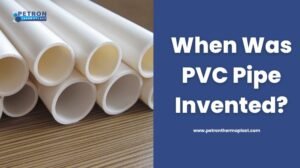Introduction
Plastic pipes have undergone significant evolution over the years, revolutionizing the building industry. We can expect to witness further advancements in plastic pipe technology that will enhance their performance, durability, and sustainability. In this blog, we will explore the top 10 evolution of plastic pipes in the building industry, highlighting their benefits and impact on engineering plastics.
Top 10 Evolution of Plastic Pipe in the Building Industry
1. Introduction of High-Strength Plastic Pipes
One notable evolution in the plastic pipe industry is the development of high-strength plastic pipes. These pipes are engineered to withstand higher pressures and offer enhanced structural integrity. The advancements in polymer formulations and manufacturing techniques have enabled the production of plastic pipes with superior strength properties, making them suitable for a wide range of applications in the building industry.
2. Increased Use of Composite Plastic Pipes
Composite plastic pipes, which combine different materials to optimize performance, are gaining popularity in the building industry. These pipes often consist of a plastic inner layer and a reinforced outer layer, resulting in improved strength, rigidity, and resistance to external factors such as impact and UV radiation. The utilization of composite plastic pipes enhances the overall durability and longevity of plumbing systems.
3. Enhanced Resistance to Chemicals and Corrosion
We can expect plastic pipes to offer even better resistance to chemicals and corrosion. The development of advanced engineering plastics with improved chemical resistance properties ensures that plastic pipes can withstand harsh substances and corrosive environments. This evolution makes plastic pipes suitable for a wide range of applications in the building industry, including plumbing, HVAC systems, and industrial processes.
4. Integration of Smart Technologies
As the building industry becomes more digitized, plastic pipes are being integrated with smart technologies. For example, some plastic pipes are equipped with sensors that can monitor flow rates, detect leaks, and provide real-time data on the condition of the plumbing system. These smart plastic pipes enable proactive maintenance, reducing the risk of costly water damage and improving overall efficiency.
5. Adoption of Eco-Friendly Materials
With growing environmental concerns, the building industry is embracing eco-friendly materials, including sustainable plastics. Plastic pipes made from recycled materials or bio-based polymers are becoming more prevalent. These pipes not only reduce the demand for virgin plastic but also contribute to a circular economy by promoting the use of recycled materials. The incorporation of eco-friendly plastic pipes aligns with sustainable construction practices and reduces the environmental footprint of buildings.
6. Improved Insulation Properties
Plastic pipes are being engineered with enhanced insulation properties, allowing for better energy efficiency in buildings. The improved insulation helps to minimize heat loss or gain, reducing the energy requirements for heating and cooling systems. By using plastic pipes with improved insulation, buildings can achieve better energy performance, leading to lower energy consumption and cost savings.
7. Advancements in Joining Techniques
Joining plastic pipes has traditionally been a critical aspect of plumbing installations. We can expect to see advancements in joining techniques for plastic pipes, including innovative methods such as fusion welding and push-fit connections. These techniques offer improved strength, leak resistance, and ease of installation, reducing labor costs and enhancing the overall efficiency of building projects.
8. Integration of Anti-Microbial Properties
To enhance hygiene and safety, plastic pipes are now being manufactured with anti-microbial properties. These properties help inhibit the growth of bacteria and other microorganisms within the plumbing system, ensuring cleaner and healthier water supply. The integration of anti-microbial properties in plastic pipes is particularly crucial for applications in healthcare facilities, food processing plants, and other environments where sanitation is paramount.
9. Development of Flexible Plastic Pipes
Flexible plastic pipes have gained popularity due to their ease of installation and adaptability to various building layouts. We can anticipate the further development of flexible plastic pipes, offering improved flexibility and bendability without compromising their structural integrity. The use of flexible plastic pipes simplifies plumbing installations, reduces the need for complex joint systems, and enables faster construction timelines.
10. Expansion of Size Range and Applications
Plastic pipes are available in a wide range of sizes to cater to diverse building applications. The size range of plastic pipes is expected to expand further, accommodating larger diameters for high-flow systems and smaller sizes for specialized applications. This evolution ensures that plastic pipes can be utilized in various building projects, from residential homes to large-scale commercial and industrial complexes.
Conclusion
The top 10 evolution of plastic pipe in the building industry brings forth numerous advancements and benefits. From high-strength pipes to eco-friendly materials, smart technologies, and improved insulation, plastic pipes continue to play a vital role in modern construction practices. As engineering plastics continue to evolve, we can expect plastic pipes to offer even greater durability, performance, and sustainability in the years to come.
You may also like – Gear Manufacturer | UHMW Plastic | PEEK Parts
FAQs
Q. What is the future of PVC pipe?
A. The future of PVC pipes looks promising. They are expected to continue being widely used due to their durability, affordability, and versatility. Advancements in technology may lead to improved production methods and eco-friendly alternatives, ensuring their sustainability in the long run.
Q. What is the future of CPVC pipes?
A. The future of CPVC pipes looks promising. They are known for their durability, affordability, and resistance to corrosion. With advancements in manufacturing techniques and increased awareness of their benefits, CPVC pipes are likely to see continued growth and adoption in various plumbing and industrial applications.
Q. What are the 10 most common uses for PVC?
Plumbing pipes and fittings.
Electrical conduits and wiring.
Vinyl siding for buildings.
Window frames and profiles.
Flooring and carpet backing.
Shower curtains and liners.
Medical tubing and bags.
Vinyl records.
Toys and inflatable structures.
Signage and banners.
Q. Is PVC plastic eco friendly?
A. PVC plastic is generally considered not eco-friendly due to its production process, toxic additives, and difficulty in recycling. Its long-term environmental impact, including release of harmful chemicals, makes it a less sustainable choice compared to other materials.
Q. What is the formula for PVC?
A. The formula for Polyvinyl Chloride (PVC) is (C2H3Cl)n, where n represents the number of repeating units in the polymer chain. PVC is a synthetic plastic widely used in various applications due to its durability and versatility.
Q. Where is PVC used in construction?
A. PVC (Polyvinyl Chloride) is used in construction for various applications such as pipes, fittings, window frames, flooring, roofing membranes, electrical insulation, and more. It is valued for its durability, affordability, and versatility in both residential and commercial buildings.





Pingback: beautiful girls
Pingback: โปรแกรมจัดการงาน